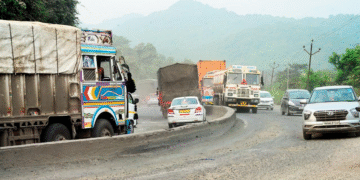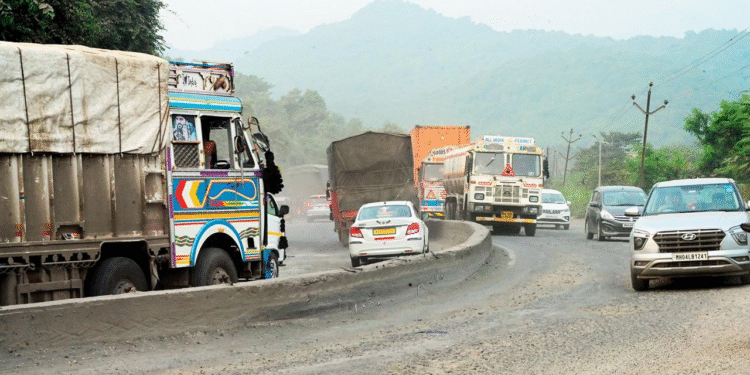Mumbai–Ahmedabad Highway traffic jam causes postponement of 20 school picnics to Vasai, rescheduled until Diwali for smoother travel
Mumbai / Palghar / Vasai, October 16, 2025 — A massive traffic gridlock along the Mumbai–Ahmedabad National Highway (NH‑48) severely disrupted school excursions, prompting more than 20 schools to postpone their planned picnics to Vasai until after Diwali. The gridlock, which stretched over many hours and trapped hundreds of students aboard buses, has underscored persistent infrastructure and traffic management failures on one of the region’s most vital road corridors.
The chain of events — from stranded buses to diplomatic complaints, acts of relief from community groups, and decisions by school administrations — lays bare how large-scale traffic disruptions can ripple into the social and educational lives of children and families.
The Jam That Broke Plans: What Happened

The Gridlock Begins
On the evening of Tuesday, around 5:30 PM, multiple school buses carrying students from various Mumbai and Thane-area schools began their return journey from picnic spots near Virar / Vasai. But barely into the route on NH‑48 in the Palghar / Vasai region, the buses became ensnared in a massive jam. The highway, already under stress from diverted traffic and repair works, could not absorb the load. Over the course of the night, progress was painfully slow — many students remained stuck on buses, in some cases for over 10–12 hours.
The snag was worsened by the diversion of heavy vehicles from the Ghodbunder Road — under repair — back onto NH‑48, placing unexpected pressure on the route.
Students Stranded, Hungry & Anxious
Report after report describes students trapped without sufficient food or water. Many were fatigued, anxious, and in distress. Teachers and bus staff attempted to provide whatever relief they could, arranging for water, snacks, and comfort — often by walking to nearby shops or requesting support from local residents.
Local volunteers and social organizations pitched in, delivering biscuits and water to stranded students. Some buses were allowed limited movement under police escort during early dawn hours.
Parents watched in agony from home, following live updates, calls, and nervous waits. Many were shocked to see how a routine school picnic spiraled into a nightmare on wheels.
Authorities Scramble, Jam Persists
Traffic police, local administration, and school officials coordinated efforts, but relief arrived slowly. Attempts to clear traffic, manage diversions, deploy additional police units, and piloting buses through narrow stretches were ongoing throughout the night.
In one notable incident, MNS chief Raj Thackeray was credited with arranging help for students. His party workers reportedly coordinated with authorities, provided support at the jammed site, and helped some students reach safety.
By early morning (around 5–6 AM), the jam slowly eased enough for buses to inch forward. But the damage was done: many school trips were ruined, students exhausted, and trust in highway management shaken.
The Aftermath: Postponements & School Decisions

20+ School Picnics Deferred
In the aftermath, school administrations across Mumbai and Thane announced the postponement of more than 20 upcoming picnics to Vasai / nearby spots, scheduling them only after Diwali vacations. Anil Garg, chairman of the Educational Tour Operators Association, confirmed that the decision was made to avoid repeating the disaster.
Some planned excursions from schools in Dadar, Malwani, Kandivli, and other suburbs were cited in reports as among those deferred.
Disruptions Beyond Students
- College and group outings also faced delays or cancellations as organizers reassessed feasibility under risk.
- Parents, employers, and city traffic witnessed knock-on effects: late arrivals, interruptions in commuting, and resource constraints for alternate travel.
- Tourism / local vendors in Vasai and picnic sites may see reduced footfall due to the cancellations.
Root Causes & Systemic Failures

Analysts point to a combination of factors:
1. Road Repairs & Diversions
The ongoing repair work on Ghodbunder Road pushed significant traffic (especially heavy vehicles) onto NH‑48, which was already under strain. Lane closures, detours, and partial blockages decreased throughput capacity drastically.
2. High Volume, Poor Infrastructure Readiness
NH‑48 is one of the busiest corridors connecting Mumbai and Gujarat. In peak hours, especially during holiday / festive seasons, the highway often operates at or beyond capacity. The sudden influx of buses compounded the chronic congestion.
3. Lack of Preemptive Planning & Coordination
Multiple stakeholders — traffic police, highway authorities, local municipal bodies — appear to have under‑estimated the impact of combined traffic loads and diversion plans. The lack of effective preemptive staggering of school departures, alternate route planning, and coordination contributed to the calamity.
4. Weak Emergency Response Infrastructure
When buses began stalling, relief responses (water, food, alternate routing) were ad hoc and late. The absence of emergency lanes, staging zones, or rapid mobilization of support worsened suffering.
Voices & Reactions
From Schools & Students
“What was supposed to be a fun outing turned into a harrowing ordeal. Many students cried, others fainted, and teachers walked miles to find water,” recounted a teacher from one of the stranded buses.
Another school official lamented the decision: “We couldn’t predict this magnitude, but next time we’ll rethink timing and route. Never again during heavy traffic times.”
From Parents & Community
Parents expressed anger at lack of communication and safeguards. “Our children left at 4 PM and returned at dawn. Why didn’t authorities warn us?” asked one parent.
Local residents along highway stretches voiced frustration at recurring gridlocks and lack of sustained infrastructure upgrades.
From Authorities & Politicians
Traffic police admitted delays in clearing the jam but emphasized efforts underway. Some officials acknowledged underestimating the “spillover effect” from roadworks.
Political leaders (like Raj Thackeray) who intervened in relief efforts received public appreciation from civil society figures.
What This Signals & What Needs to Change
This traffic debacle is not an isolated event — it highlights deeper, recurring challenges:
A. Reassess School Tour Scheduling
School administrations must analyze risk: avoid late departures, plan buffer times, and coordinate with traffic agencies, especially during repair seasons or festive periods.
B. Controlled Heavy Vehicle Movement
Authorities should enforce stricter restrictions on heavy truck / vehicle movement during peak hours or when alternative routes are under repair.
C. Phased Infrastructure Upgrades & Diversions
Upgrades to highways, alternative corridors, bypasses, proper diversion planning, and modular lane allocation could reduce impact when one route is compromised.
D. Emergency Support & Relief Protocols
Deploy standby water / food supply units, mobile medical teams, and staging zones along highway stretches to assist stranded commuters.
E. Real‑Time Communication
Robust real‑time alerts (via apps, SMS, social media) to inform drivers, schools, and public of gridlocks, alternate routes, or suggestions could mitigate panic and prevent additional congestion.
F. Stakeholder Coordination
Traffic police, municipal bodies, school boards, and highway authorities need joint planning mechanisms ahead of high-risk days (festivals, repair windows).
Timeline Snapshot
| Time | Event / Development |
|---|---|
| ~5:30 PM | Buses carrying school students depart for Mumbai; get stuck near Vasai stretch of NH‑48 |
| Evening to Night | Traffic slows progressively; students remain trapped on buses, minimal movement |
| Late Night / Early Dawn | Volunteers, local efforts, police escort allow some bus movement; grid clears partially |
| Following Day | Schools announce postponements of picnics until after Diwali |
Also Read : Abhishek Kumar performs Griha Pravesh puja at his first home in Mumbai; see pics















 Categories
Categories









